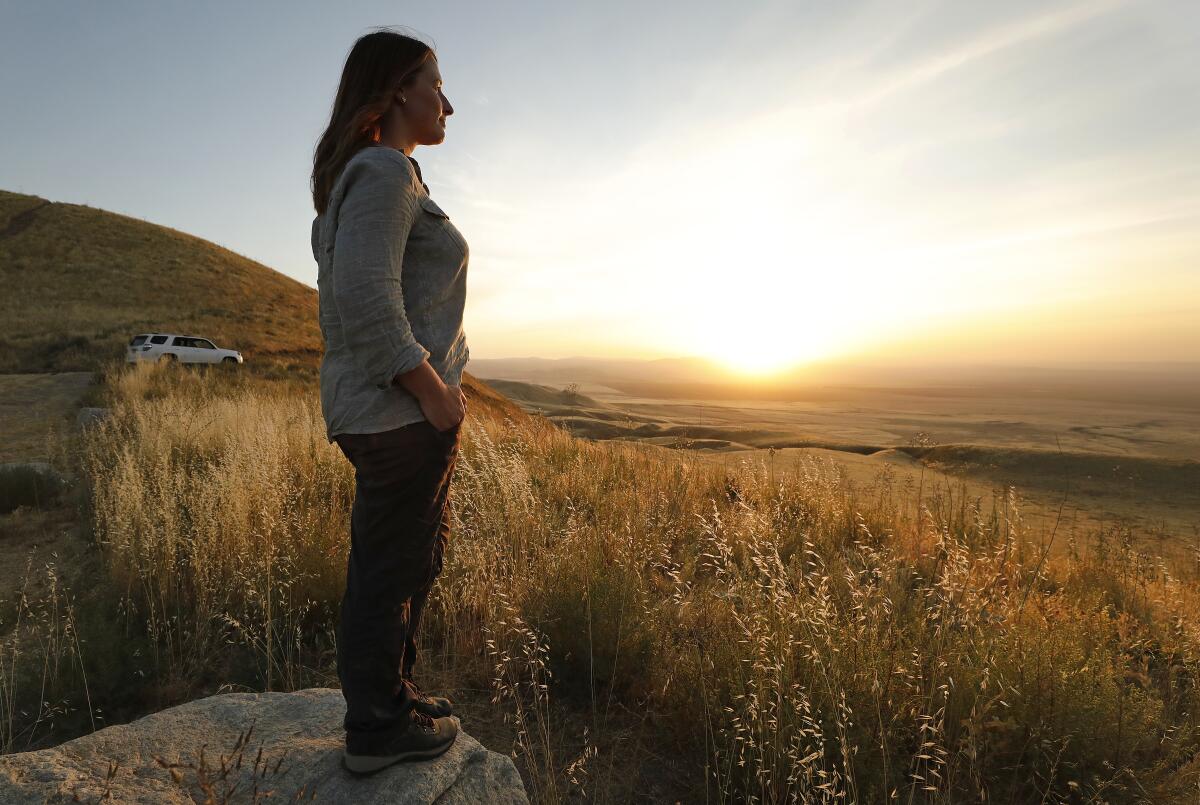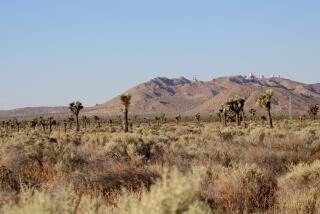California farmers are planting solar panels as water supplies dry up
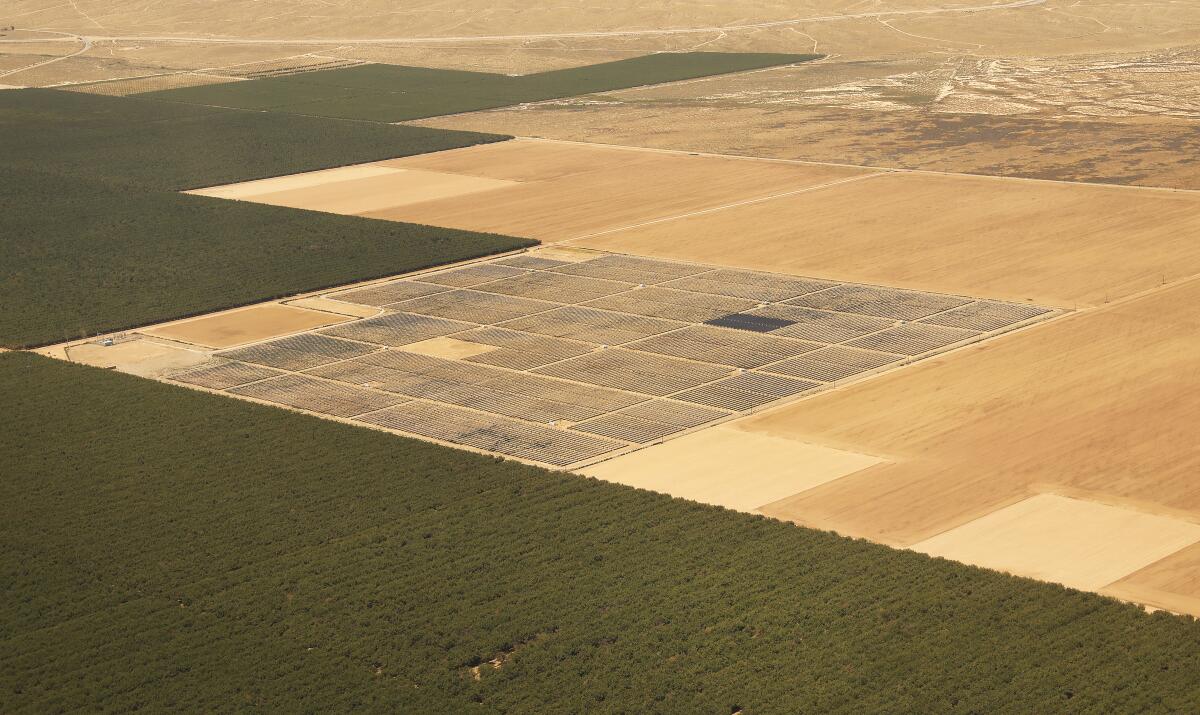
- Share via
MARICOPA, Calif. — Jon Reiter banked the four-seat Cessna aircraft hard to the right, angling to get a better look at the solar panels glinting in the afternoon sun far below.
The silvery panels looked like an interloper amid a patchwork landscape of lush almond groves, barren brown dirt and saltbush scrub, framed by the blue-green strip of the California Aqueduct bringing water from the north. Reiter, a renewable energy developer and farmer, built these solar panels and is working to add a lot more to the San Joaquin Valley landscape.
“The next project is going to be 100 megawatts. It’s going to be five times this size,” Reiter said.
Solar energy projects could replace some of the jobs and tax revenues that may be lost as constrained water supplies force California’s agriculture industry to scale back. In the San Joaquin Valley alone, farmers may need to take more than half a million acres out of production to comply with the Sustainable Groundwater Management Act, which will ultimately put restrictions on pumping.
Converting farmland to solar farms also could be key to meeting California’s climate change targets. That’s according to a new report from the Nature Conservancy, an environmental nonprofit.
Working with the consulting firm Energy and Environmental Economics, the conservancy tried to figure out how California could satisfy its appetite for clean energy without destroying ecologically sensitive lands across the American West. The report lays out possible answers to one of the big questions facing renewable energy: Which areas should be dedicated to solar panels and wind turbines, and which areas should be protected for the sake of wildlife, outdoor recreation, farming and grazing?
One takeaway from the report, released this week: California will need hundreds or maybe thousands of square miles of solar power production in the coming decades — and it would make sense to build one-third to one-half of that solar capacity on agricultural lands, mostly within the state.
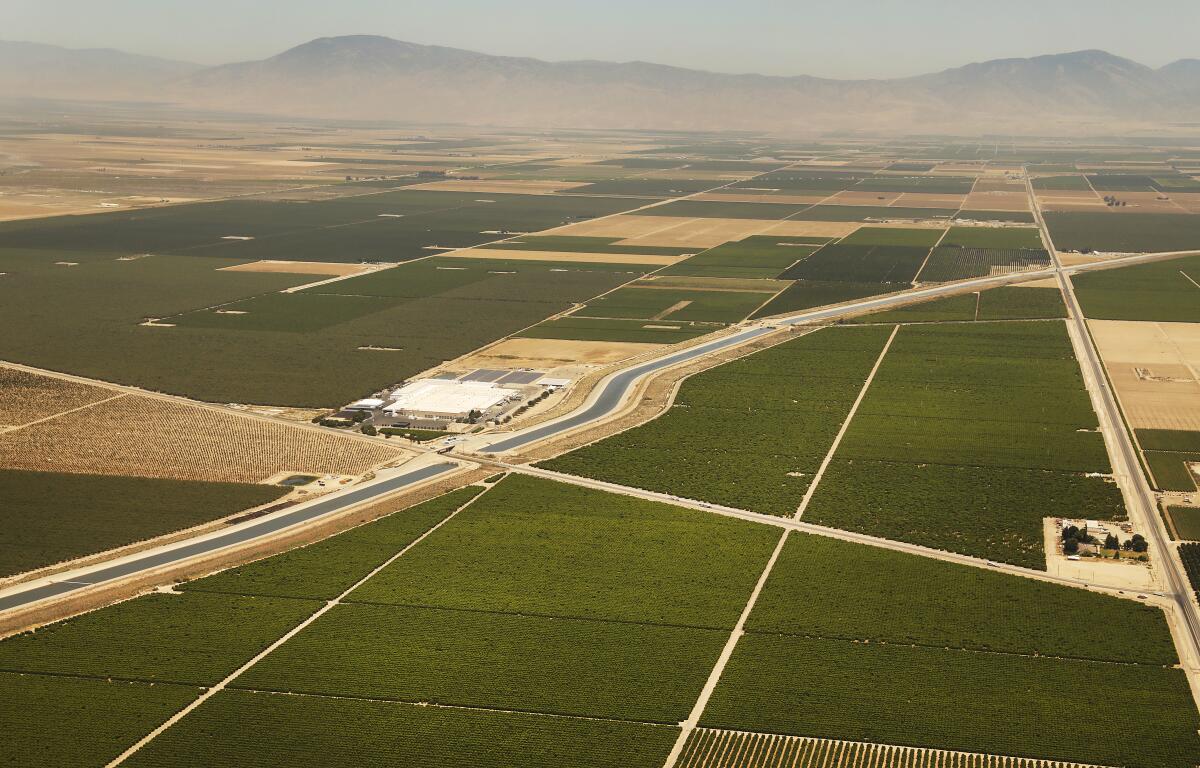
In part, that’s because the Central Valley is more ecologically degraded than California’s inland deserts, where bighorn sheep, desert tortoises and golden eagles still roam across vast stretches of largely intact wilderness. The San Joaquin Valley is home to two dozen threatened and endangered species, but the landscape was almost totally reshaped by agriculture long ago.
California has plenty of farmland that could be converted to solar panels without harming the state’s $50-billion agriculture industry, clean energy advocates say. A previous report identified 470,000 acres of “least-conflict” lands in the San Joaquin Valley, where salty soil, poor drainage or otherwise less-than-ideal farming conditions could make solar an attractive alternative for landowners.
At least 13,000 acres of solar farms have already been built in the valley, said Erica Brand, director of the Nature Conservancy’s California energy program and a coauthor of the newly released “Power of Place” report.
“It’s a region with tremendous opportunity to advance multi-benefit solar projects,” Brand said.
Building solar and saving species
For an increasing number of farmers, solar makes economic sense.
At Maricopa Orchards — a major Fresno-based grower of almonds, oranges and other crops — Reiter hatched a plan to build solar panels on thousands of acres of agricultural land in Kern County.
He worked with local officials to create a 6,000-acre habitat conservation plan, which allows solar panels on 4,000 acres of the company’s land and sets aside 2,000 additional acres for environmental mitigation. The mitigation lands are now reverting back to habitat for San Joaquin kit foxes, blunt-nosed leopard lizards, burrowing owls and other at-risk species.
Reiter’s vision is a work in progress: So far, only 160 acres have been developed with solar. The 20-megawatt Maricopa West solar project was built by the German company E.ON and sold to Dominion Energy of Virginia, on land adjacent to almond orchards.
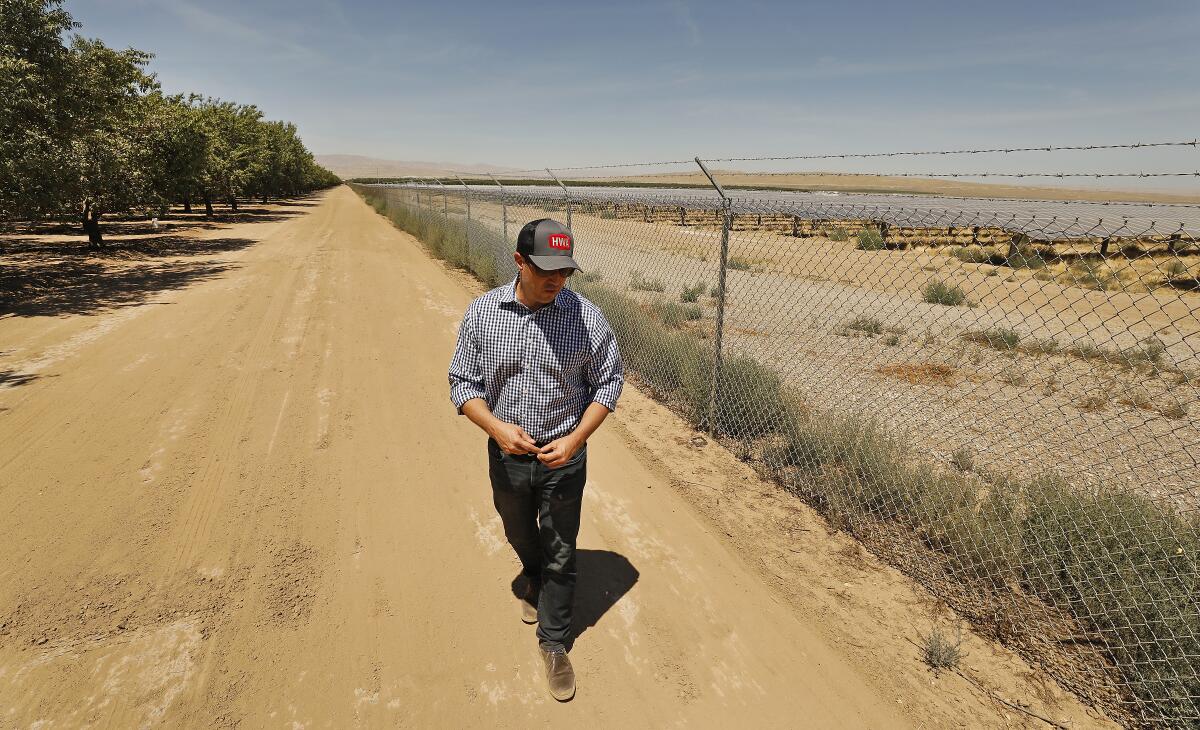
But Reiter, who served as Maricopa Orchards’ chief executive until earlier this year and is now a senior adviser to the company, said he’s negotiating with three developers looking to build seven more solar projects. Part of the benefit of the habitation conservation plan, Reiter said, is that Maricopa can offer solar companies “shovel-ready” construction sites with permits and mitigation lands ready to go, saving them time and money.
Endangered species also stand to benefit from the habitat plan.
“There’s going to be artificial dens, movement corridors and things of that nature. The idea is that it’s going to help them survive,” Reiter said.
Other Central Valley agricultural powerhouses have their own plans for solar.
Wonderful Co. — which grows tree nuts and owns Pom Wonderful, Fiji Water and Justin Wines — is aiming to power its operations with 100% renewable electricity by 2025. Wonderful opened its first solar project in 2007 and this year signed a contract with Florida-based developer NextEra Energy for a 23-megawatt solar installation, to be built on 157 acres of fallow farmland.
Wonderful sees “tremendous potential for siting solar on agricultural land,” said Steven Swartz, the company’s vice president of strategy. Wonderful, owned by Beverly Hills billionaires Stewart and Lynda Resnick, can make about as much money producing solar power over a 30-year period, Swartz said, as it can growing almonds and pistachios, two of the most lucrative crops grown in California and also two of the most water-intensive.
“In one case we’re growing an agricultural product that has value, and in another case we’re producing electrons that have value,” Swartz said.
Swartz added that he expects “relatively limited competition” between solar and agriculture because there’s already so much farmland that isn’t in production in the Central Valley. Wonderful has 10,000 acres it’s keeping fallow, he said, due either to poor soil conditions or insufficient water. In 2015, at the height of California’s most recent drought, Central Valley farmers kept about 1 million acres idle all year, NASA scientists estimated.
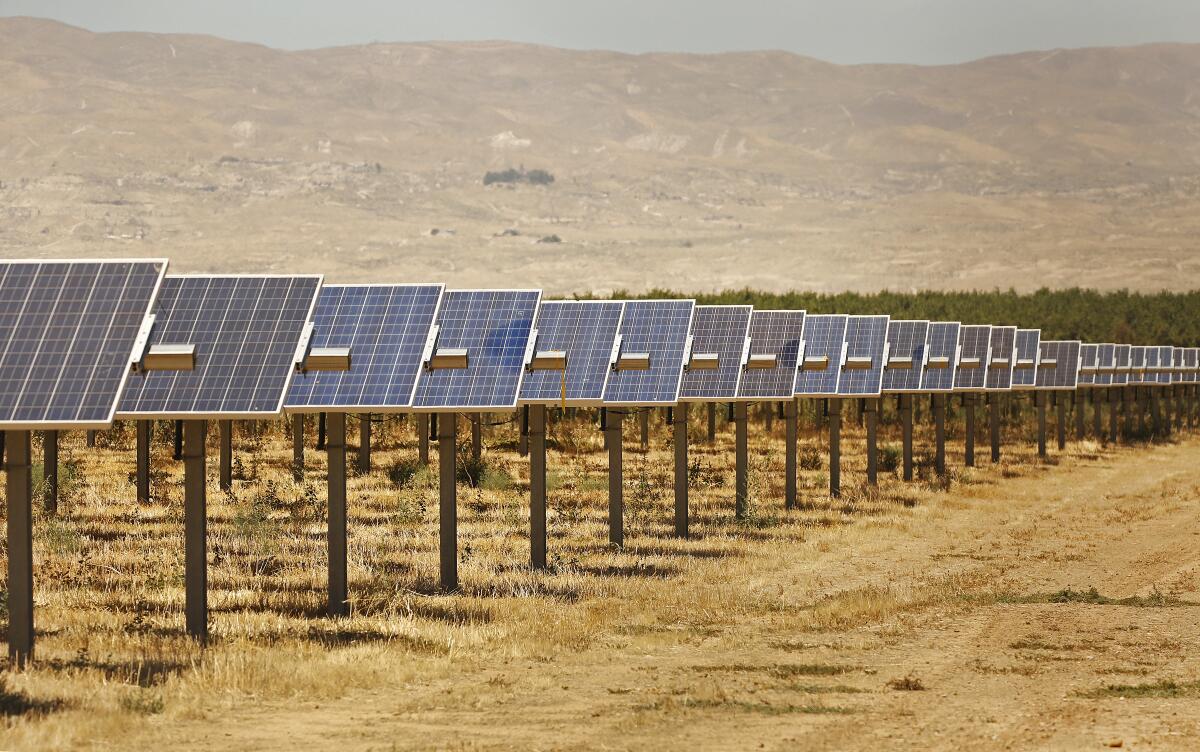
The biggest solar project being planned in the Central Valley is Westlands Solar Park, where construction of the first 670 megawatts is scheduled to begin in the next few months, said Daniel Kim, vice president of regulatory and government affairs for the developer, Golden State Clean Energy. The project could eventually grow to 2,700 megawatts of power across 20,000 acres, which is larger than any solar power facility in the world today.
The massive solar project will be built on “drainage-impaired” farmlands served by Westlands Water District, where the soil has become loaded with crop-killing salts — and toxic selenium — because clay layers beneath the dirt prevent irrigation water from percolating down into the underground aquifer.
“If you continue to farm these types of lands, you continue to make the drainage problems worse and worse,” Kim said.
Poor drainage and groundwater restrictions aren’t the only reasons farmers are looking to solar power. Surface water supplies also have become increasingly unreliable, in part because of environmental regulations that limit how much water can be pumped from the Sacramento-San Joaquin River Delta.
How much will it cost to ditch fossil fuels?
The Nature Conservancy’s “Power of Place” report doesn’t look only at farmland.
The report examines 61 scenarios for achieving California’s climate targets. They’re based on different assumptions about how much land is protected from development across 11 Western states, how many homes add rooftop solar panels, how much lithium-ion battery prices fall, and whether California continues to require that most of its solar and wind power be produced within the state.
One of the report’s conclusions is that switching from fossil fuels to clean energy gets more expensive as more land is shielded from development.
For instance, annual electricity costs could be around $110 billion if most of California’s renewable energy is produced in-state and only legally protected areas such as national parks and wildlife refuges are off-limits to developers. Statewide electricity costs could rise to $125 billion if development were prohibited on other lands, such as critical habitat for endangered species and important bird areas.
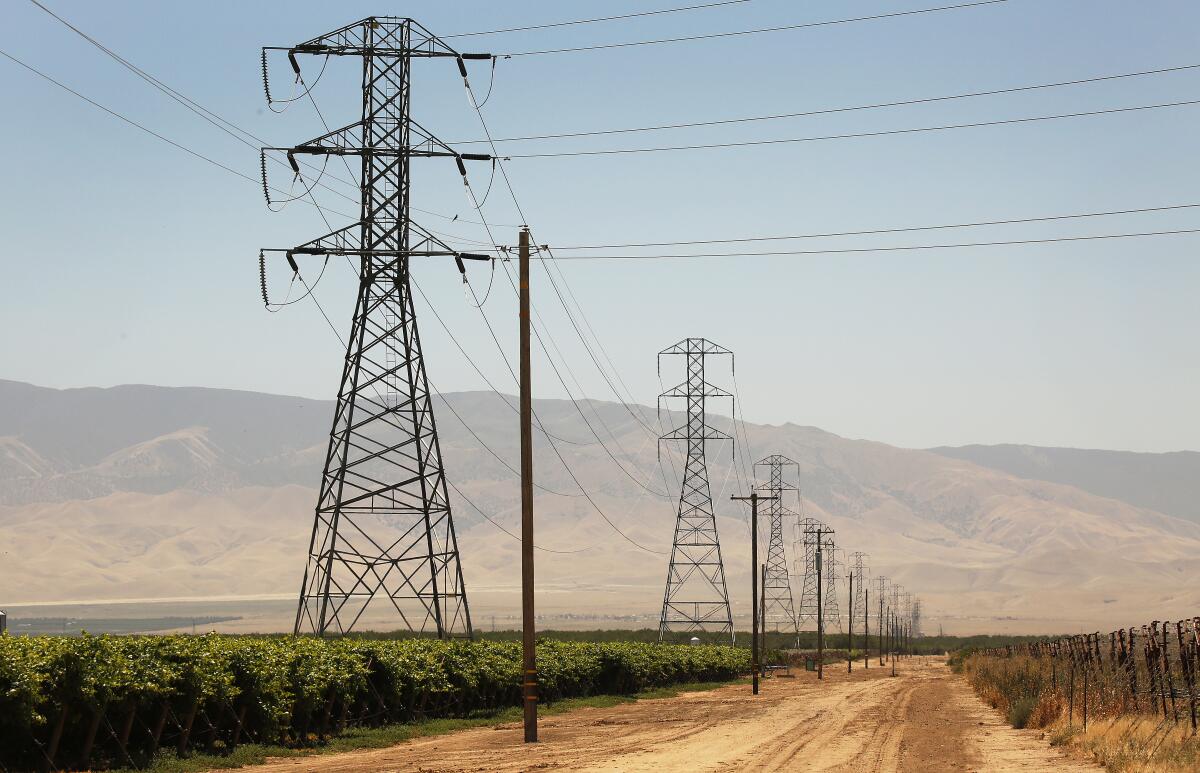
But if California utilities were allowed to buy more renewable energy from other Western states, annual costs would drop to $113 billion even under the most restrictive land-use rules, the report estimates. Easing land-use rules slightly would bring electricity costs down to $106 billion — cheaper than trying to build everything in-state, even if hardly any lands are off-limits.
“That West-wide scenario is the best-case scenario,” said Arne Olson, a senior partner at the consulting firm Energy and Environmental Economics and a co-author of the Nature Conservancy’s report.
The “Power of Place” report doesn’t capture every force that could shape California’s energy future. It assumes no development of offshore wind power, despite enormous potential for turbines off the Pacific coast. It also doesn’t account for other states’ renewable energy needs, which could be substantial.
Still, clean energy advocates say the document could help California officials balance development with ecosystem protection as they plan for 100% climate-friendly electricity by 2045, the target adopted by lawmakers last year. In 2018, California received 31% of its electricity from renewables including solar and wind, and 20% from zero-carbon nuclear and large hydropower facilities.
The Nature Conservancy’s report “appears to outline thoughtful options for how to site the projects we need to meet the climate crisis,” said Shannon Eddy, executive director of the Large-Scale Solar Assn., a Sacramento trade group.
It’s gotten more difficult to build solar in recent years, Eddy said, as conservationists have fought projects in wilderness areas and rural residents have fought projects near their communities. In February, San Bernardino County, California’s largest by area, banned the construction of large solar and wind farms on more than 1 million acres of private land.
The price of continuing with business as usual, Eddy said, “is basically losing the battle on climate change.”
“We can no longer afford to fight about this. We need all the power we can get as fast as we can get it,” she said.
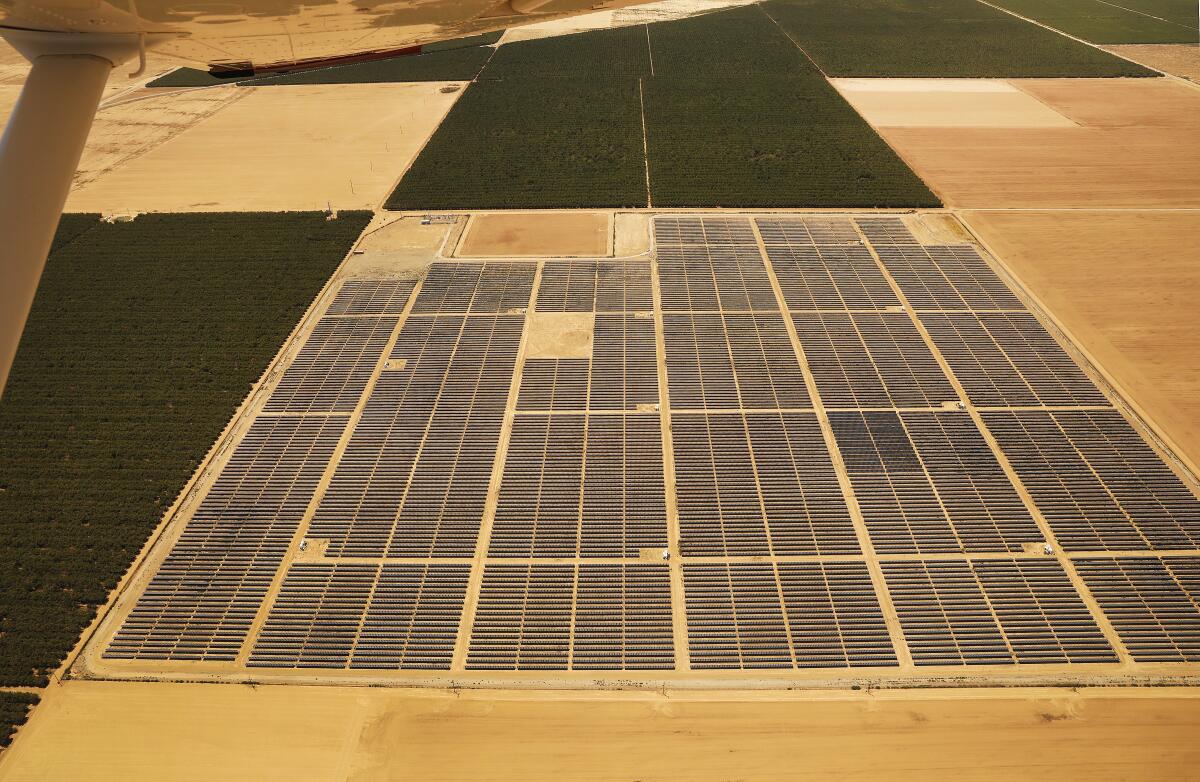
Kim Delfino, California program director for Defenders of Wildlife, is hopeful the Nature Conservancy’s findings will help forestall the kinds of ecological conflicts that have slowed clean energy development in the California desert. During the renewable energy “gold rush” of the late 2000s, developers proposed dozens of solar and wind farms in unprotected desert areas, fueling hard-fought battles with conservationists that continue today.
“We’re going to have another renewable energy boom. It’s inevitable,” Delfino said. “This will give us an opportunity, perhaps, to make better choices.”
Restoring an altered ecosystem
Wind Wolves Preserve, which is owned by the nonprofit Wildlands Conservancy, offers a unique perspective on those choices.
Spanning 93,000 acres at the southern end of the San Joaquin Valley, in the heart of the San Emigdio Mountains, the preserve is a refuge for wildlife that once roamed throughout California’s heartland, before the region became an agricultural mecca.
Two decades ago, 19 tule elk were reintroduced at the site, part of an effort to restore a population that once numbered in the hundreds of thousands. Today, more than 300 elk call the preserve home.
Wind Wolves has also been planting Bakersfield cactuses, building up what staff say is now the third-largest population of the endangered plant species.
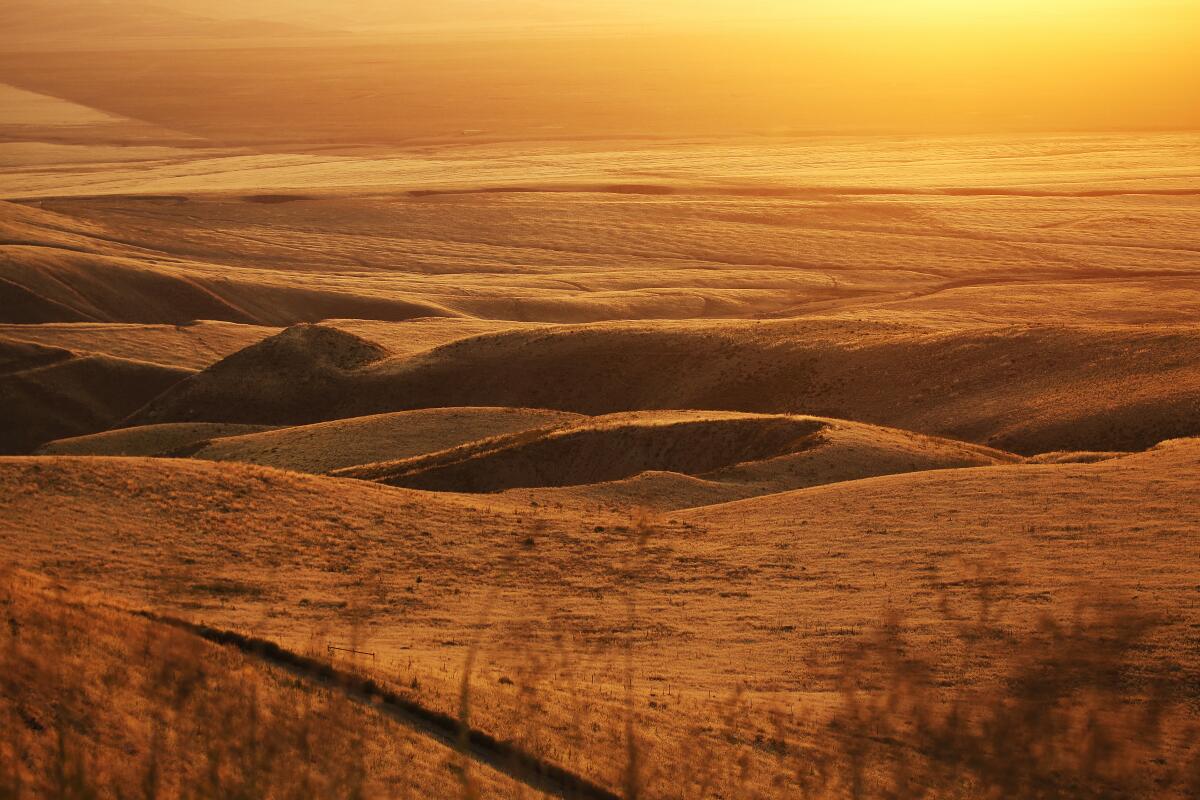
On a recent summer evening, preserve manager Melissa Dabulamanzi drove up a narrow, winding dirt road toward Tule Elk Overlook, which provides a sweeping view of the San Joaquin Valley floor. Sitting in the back seat was Abby Hart, who leads the Nature Conservancy’s California agriculture project.
“This kind of shrub-land habitat is largely what the valley should be looking like,” Dabulamanzi said
At Tule Elk Overlook, they got out of the car and looked out over the valley, admiring the landscape as the sun disappeared behind distant mountains.
Hart said solar companies, farmers and conservationists will need to work together to build a sustainable future for this region of California.
“There’s so little remaining excellent habitat like this,” Hart said, referring to the preserve. “If we can get that solar development to happen on already disturbed lands ... that’s so much better than having it touch down in areas that are either already protected or are already serving as excellent habitat.”
